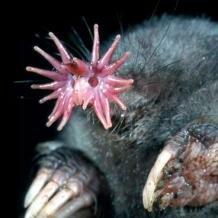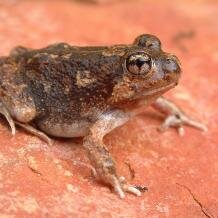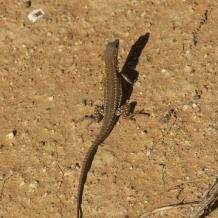Topic: Burrowing: from worms to vertebrates
Quite a few adaptations are useful for burrowing into the soil. So it is not exactly surprising that they have evolved several times...
 Burrowing has, of course, evolved many times, and simply moving through soil or sediment is so widespread as to refer to it as convergent verges on the trivial. There are, however, many specific instances where the degree of similarity is much more striking. For example, the fossorial mammals, including the moles and other burrowers, show many striking convergent adaptations to subterranean life, especially connected to communication and the senses (notably reduction or loss of eyes). Other animal groups that have independently adapted to burrowing include limbless amphibians called caecilians and certain reptiles (e.g. burrowing skinks), which have come to resemble earthworm-like annelids.
Burrowing has, of course, evolved many times, and simply moving through soil or sediment is so widespread as to refer to it as convergent verges on the trivial. There are, however, many specific instances where the degree of similarity is much more striking. For example, the fossorial mammals, including the moles and other burrowers, show many striking convergent adaptations to subterranean life, especially connected to communication and the senses (notably reduction or loss of eyes). Other animal groups that have independently adapted to burrowing include limbless amphibians called caecilians and certain reptiles (e.g. burrowing skinks), which have come to resemble earthworm-like annelids.
Burrowing amphibians
Burrowing has evolved multiple times in the amphibians.  In frogs, it takes two basic alternative routes: ‘hind feet first’, which seems to involve a less profound transition, and ‘head first’, demanding a greater degree of specialisation. Even in frogs that burrow ‘head first’, however, the overall change in body morphology is rather muted. In other amphibians, there are much more spectacular examples of morphological change associated with burrowing. Especially in some caecilians we see an extraordinary adaptation to the burrowing habit, with taxa such as Dermophis showing remarkable convergence on the annelid earthworms.
In frogs, it takes two basic alternative routes: ‘hind feet first’, which seems to involve a less profound transition, and ‘head first’, demanding a greater degree of specialisation. Even in frogs that burrow ‘head first’, however, the overall change in body morphology is rather muted. In other amphibians, there are much more spectacular examples of morphological change associated with burrowing. Especially in some caecilians we see an extraordinary adaptation to the burrowing habit, with taxa such as Dermophis showing remarkable convergence on the annelid earthworms.  In other words, a vertebrate has managed to translate itself into a worm. The crucial transition lies in the development of a hydrostatic skeleton, and just as remarkably, an almost complete detachment between the vertebral column and the outer skin and muscle. Kinematic analysis reveals that during locomotion the spine is thrown into curves (as in a snake), but as it is decoupled from the outer skin and muscle, the latter moves independently and provides successive points of contact in a way very similar to that seen in the progression of the earthworms. In addition to this decoupling, and central to the burrowing activity, there is an array of tendons that form a crossed helix. This is surely a compelling example of convergence – given its body plan, who would have ever expected a vertebrate to manage to become so worm-like?
In other words, a vertebrate has managed to translate itself into a worm. The crucial transition lies in the development of a hydrostatic skeleton, and just as remarkably, an almost complete detachment between the vertebral column and the outer skin and muscle. Kinematic analysis reveals that during locomotion the spine is thrown into curves (as in a snake), but as it is decoupled from the outer skin and muscle, the latter moves independently and provides successive points of contact in a way very similar to that seen in the progression of the earthworms. In addition to this decoupling, and central to the burrowing activity, there is an array of tendons that form a crossed helix. This is surely a compelling example of convergence – given its body plan, who would have ever expected a vertebrate to manage to become so worm-like?
Burrowing reptiles
In the reptiles, adaptations for burrowing have also evolved independently many times. Tuatara and some turtles make burrows for themselves, but worm-like burrowing as in caecilians is seen in a diversity of lineages within the squamates, the group comprising lizards, snakes and ‘worm lizards’ (amphisbaenians).
Charismatic among the burrowing lizards are the sand-dwelling forms (that define a distinct ecomorph) that inhabit arid regions of Africa, the Americas and Australia. Amazingly they include species from six independent groups: geckos, iguanids, skinks, agamids (‘dragon lizards’), gerrhosaurids (‘plated lizards’) and lacertids (‘true lizards’). These lizards are capable of ‘sand-diving’ and move efficiently through sandy substrate thanks to fringes or spines on their toes, a pointed or spade-like snout, a cylindrical body and adaptations for breathing when submerged.  Just a few examples of sand-diving lizards that inhabit the Namib desert include Agama etoshae (agamid), Pachydactylus rengei (gecko), Angolosaurus skoogi (gerrhosaurid), Meroles anchietae (lacertid) and the skink Riopa sundevallii.
Just a few examples of sand-diving lizards that inhabit the Namib desert include Agama etoshae (agamid), Pachydactylus rengei (gecko), Angolosaurus skoogi (gerrhosaurid), Meroles anchietae (lacertid) and the skink Riopa sundevallii.
The so-called ‘burrowing skinks’ (family Scincidae) are perhaps most specialized among fossorial lizards, displaying a progression of limb loss (e.g. among Scleotes species of Southern Africa), up to entirely limbless, worm-like species (e.g. the Western burrowing skink Typhlacontias of Southern Africa and Janetascincus and Pamelascincus endemic to the Seychelles). Burrowing skinks have a flattened snout like the sand-divers, smooth overlapping scales for efficient movement and they tend to lack eyes, eyelids and external ear openings.  Other limbless lizards include the ‘slow worms’ (family Anguidae), which are semi-fossorial and include species such as Anguis fragilis.
Other limbless lizards include the ‘slow worms’ (family Anguidae), which are semi-fossorial and include species such as Anguis fragilis.
Among the snakes, a remarkable group called the ‘atractaspids’ (e.g. the Southern African burrowing asp Atractaspis bibronii) have independently evolved adaptations for burrowing into sandy soils, including smooth scales and fangs that swing sidewards to inject prey within their tunnels.
Astonishingly annelid-like are the aptly named ‘worm lizards’ or amphisbaenians, a lineage distinct from true lizards or snakes in which limb loss and head and skeleton morphology suited for an underground existence seem to have evolved several times. Examples include the limbless shovel-headed Rhineura floridana, the keel-headed Anops kingii and Bipes bioporus, which has tiny forelimbs. Added to what we know of amphibians, these reptiles make the convergent evolution of worm-like body plans even more compelling.
As a final note on convergent burrowing mechanisms, the way in which many animals burrow also follows a specified ‘burrowing cycle’, which despite widely divergent anatomies basically relies on the same set of movements.
Cite this web page
Map of Life - "Burrowing: from worms to vertebrates"
https://mapoflife.org/topics/topic_37_burrowing-from-worms-to-vertebrates/
May 3, 2021

